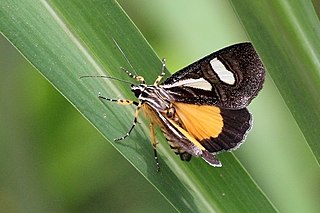Agathiphaga is a genus of moths, known as kauri moths. and is the only living genus in the family Agathiphagidae. This caddisfly-like lineage of primitive moths was first reported by Lionel Jack Dumbleton in 1952, as a new genus of Micropterigidae.

Agoma is a monotypic moth genus of the family Noctuidae erected by Sergius G. Kiriakoff in 1977. Its only species, Agoma trimenii, or Trimen's false tiger, was first described by Rudolf Felder in 1874. It is known from most countries of subtropical Africa.
Dyops is a genus of moths of the family Noctuidae. The genus was erected by Achille Guenée in 1852.

Eudesmeola is a monotypic moth genus of the family Erebidae erected by George Hampson in 1926. Its only species, Eudesmeola lawsoni, or Lawson's night moth, was first described by Felder and Rogenhofer in 1874. It is found in the dry inland areas of Australia.
Focillistis is a monotypic moth genus of the family Erebidae erected by George Hampson in 1926. Its only species, Focillistis sita, was first described by Felder and Rogenhofer in 1874. It is found in Sumatra, Nias, Borneo and Sulawesi.
Hemicephalis is a genus of moths of the family Erebidae. The genus was erected by Heinrich Benno Möschler in 1890.

Marsipiophora is a genus of moths of the family Erebidae. The genus was erected by Oscar John in 1909.
Mazacyla is a genus of moths of the family Erebidae. The genus was erected by Francis Walker in 1865.
Metaprosphera is a genus of moths of the family Erebidae. The genus was erected by George Hampson in 1926.
Orthogrammica is a genus of moths of the family Erebidae. The genus was erected by George Hampson, an English entomologist, in 1926.
Pachyplastis is a monotypic moth genus of the family Erebidae. Its only species, Pachyplastis apicalis, is found in the Brazilian state of Amazonas. Both the genus and species were first described by Felder in 1874.
Parargidia is a genus of moths of the family Erebidae. The genus was erected by George Hampson in 1926.
Perinaenia is a monotypic moth genus of the family Erebidae erected by Arthur Gardiner Butler in 1878. Its only species, Perinaenia accipiter, was first described by Felder in 1874. It is here provisionally treated as separate from Xestia, though it seems closely related. Its closest living relatives are not resolved and thus the genus' eventual fate depends on how Xestia is treated.
Polygoniodes is a genus of moths of the family Erebidae. The genus was erected by George Hampson in 1926.

Tautobriga is a genus of moths in the family Erebidae. The genus was erected by Francis Walker in 1869.
Choerotricha is a genus of tussock moths in the family Erebidae. The genus was described by Felder in 1874.
Desmoloma is a genus of moths in the subfamily Lymantriinae. The genus was described by Felder in 1874.

Micromorphe is a genus of tussock moths in the family Erebidae. The genus was erected by Felder in 1874.
Clemmatista is a monotypic moth genus in the family Cosmopterigidae. Its single species, Clemmatista metacirrha, is found in India. Both the genus and species were first described by Edward Meyrick in 1921.
Chrysopeleia purpuriella is a moth that belongs to family Cosmopterigidae and to the superfamily Gelechioidea. It was described by Vactor Tousey Chambers in 1874. It is found in North America, where it has been recorded from Arkansas, Illinois, Kentucky, New York and Ohio.




